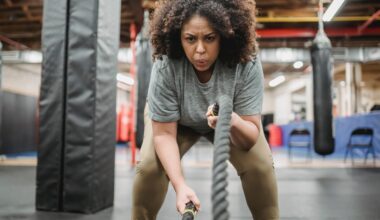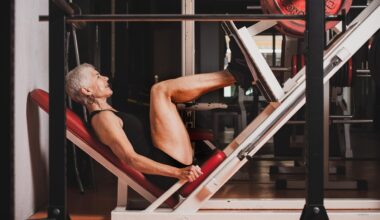Advanced Strength and Conditioning Techniques for Experienced Lifters
Experienced lifters often seek advanced strength and conditioning techniques to enhance their performance and results. Understanding the principles behind progressive overload is crucial for continual improvement. This technique involves systematically increasing the weights, repetitions, or intensity of workouts over time. Lifters must also vary their routines to avoid plateaus and stimulate muscle growth. Incorporating compound movements, such as squats, deadlifts, and bench presses, enhances muscle recruitment and fosters better strength gains. Additionally, employing supersets and dropsets can increase workout intensity and promote muscle endurance. Another effective method is focusing on eccentric training, where the emphasis is on the lowering phase of an exercise. By doing so, lifters can significantly develop their strength and control over a larger range of motion. Moreover, integrating functional training into a routine provides additional benefits by engaging the core and stabilizing muscles throughout various movements. This type of training translates better into daily activities and can decrease injury risk. Finally, tracking progress meticulously is essential for adapting the conditioning plan, ensuring it remains effective and aligned with personal goals.
To optimize strength and conditioning outcomes, periodization plays a vital role. This systematic approach involves cycling through different training phases focusing on various fitness components such as strength, hypertrophy, power, and endurance. Alternating these phases allows lifters to avoid psychological and physical fatigue while continually progressing. A key element of periodization is the adaptation of intensity and volume, ensuring that the muscle and nervous systems can recover adequately between higher workload cycles. Additionally, individualizing these cycles based on specific goals, whether for sporting events or personal competition is essential. Experienced athletes also benefit from incorporating deload weeks, where training intensity and volume are significantly reduced. This break helps in muscle recovery and avoids overtraining, which could hinder progress. Furthermore, incorporating mobility and flexibility work is fundamental for maintaining optimal movement quality and preventing injuries. Programs should include dynamic stretches before workouts and static stretches post-exercise. Using tools such as foam rollers and resistance bands can enhance flexibility and aid muscle recovery. Therefore, understanding the structure of a well-designed strength program can significantly improve performance and promote long-term adaptation.
Nutrition and Recovery Strategies
A well-structured strength and conditioning plan also emphasizes the importance of nutrition and recovery strategies. Consuming adequate amounts of protein post-workout is crucial for muscle repair and growth. Aim for 1.6 to 2.2 grams per kilogram of body weight daily, depending on activity levels. Additionally, a balanced intake of carbohydrates aids in replenishing glycogen stores and fuels training sessions. Understanding the timing of nutrient consumption can further enhance performance; for instance, eating a meal rich in protein and carbohydrates 30-60 minutes after exercising maximizes recovery benefits. Hydration plays another significant role in enhancing performance and recovery. Dehydration can severely affect strength and endurance, so it is essential to consume fluids before, during, and after workouts. Supplementation can also complement nutrition but should be approached with caution. Creatine, branched-chain amino acids, and omega-3 fatty acids have demonstrated efficacy in enhancing performance and recovery. However, consulting with a registered dietitian or nutritionist is advisable. Prioritizing sleep quality is also crucial, as adequate rest allows muscles to recover and rebuild, leading to optimal strength progression over time.
Alongside nutrition and sleep, mental conditioning should not be overlooked in any advanced strength and conditioning program. Developing a strong mental edge can be the difference between success and failure in physical performance. Techniques such as visualization and goal setting can enhance motivation and focus during workouts. Mental imagery, in which athletes visualize themselves achieving specific goals, can improve performance by enhancing mental rehearsal of movements. Incorporating meditation or mindfulness practices can also enhance concentration and reduce anxiety. Establishing a pre-workout routine helps set the mental state for successful training. This could involve listening to motivating music, participating in affirmations, or performing specific rituals that prepare the mind. Furthermore, regular self-assessment and reflection on training sessions enable lifters to understand their mental states and emotional responses. Engaging with a coach or trainer for accountability can further strengthen this aspect, providing necessary motivation and feedback during training. By recognizing the fusion of mental toughness and physical conditioning, experienced lifters can unlock new achievements and elevate their overall performance. A multidimensional approach ensures comprehensive growth.
Integrating Technology into Training
In today’s digital age, integrating technology into training regimens is another way to enhance strength and conditioning experiences. Utilizing fitness apps and wearables allows lifters to track their workouts accurately, monitor heart rates, and measure progress effectively. These tools offer insights into personal performance trends, aiding in program adjustment when necessary. Furthermore, video analysis can enable lifters to correct form and technique by reviewing their movements, ensuring they perform exercises safely and efficiently. Online platforms provide access to workout plans and instructional videos from seasoned trainers, making advanced techniques readily available. Engaging in virtual training communities can also offer support, motivation, and advice from fellow lifters. The use of online coaching can provide personalized programming tailored to specific goals and fitness levels while maintaining convenience. In addition, technology can facilitate setting reminders for nutrition, hydration, and workouts, becoming a valuable support system in achieving fitness goals. However, it is also vital to balance technology usage with intuitive listening to one’s body, ensuring that lifters remain attuned to their needs. A conscious approach to integrating technology can ultimately optimize training outcomes.
Lastly, continuous education on strength and conditioning techniques is fundamental for experienced lifters aiming for greatness. Attending workshops, seminars, and certification courses is an excellent way to stay informed about the latest developments and research in the fitness industry. Additionally, reading academic journals and reputable fitness publications can deepen one’s understanding of evolving techniques and methodologies. Engaging with mentors or seasoned professionals can offer valuable insights that simply do not yield from independent study. Building a community or network of like-minded individuals encourages sharing experiences and knowledge about effective strategies. Online forums or local meetups can create spaces for discussion and idea exchange. Furthermore, embracing a growth mindset is critical; viewing challenges as opportunities fosters resilience and adaptability in training. As new information arises, revisiting and adapting personal training plans ensures that they remain effective and aligned with the latest best practices. Lifters committed to ongoing education and adaptability often see the most significant advancements in their strength and conditioning endeavors. This continuous pursuit of knowledge is essential for unlocking potential.
In conclusion, advanced strength and conditioning techniques tailored for experienced lifters can significantly elevate performance and results. By incorporating principles of progressive overload, periodic training cycles, nutrition, recovery strategies, mental conditioning, and technology integration, lifters can leverage their training more effectively. Creating a multifaceted approach ensures that all aspects affecting performance are addressed, leading to holistic development. Lifters should prioritize proper form and technique across all exercises, ensuring safety and efficacy while striving for advancement. Ultimately, this detour into advanced methods is a journey toward greater strength, endurance, and resilience. As experienced athletes adopt and adjust new strategies, they create more personalized experiences that resonate with their unique goals and aspirations. With dedication and consistent efforts, the incredible potential within each lifter can manifest, exemplifying what is achievable in the realm of strength training. Therefore, commitment to both the physical and mental components of a training program is paramount. Achieving remarkable outcomes in strength and conditioning requires an ongoing investment in oneself. With the right mindset and knowledge, anyone can forge their path towards unmatched performance and results.
This journey of mastering advanced strength and conditioning techniques is ongoing, and every lifter’s experience is unique. Committing to lifelong learning and adaptability will be invaluable for those looking to push beyond their limitations. Each exercise, training session, and nutrition choice serves as incremental steps on the path to success. As individuals gain insights from their training and refine their techniques, they foster a culture of growth and excellence. Engaging in this transformative process not only builds physical strength but also cultivates confidence, discipline, and resilience. In conclusion, embracing advanced strength and conditioning approaches empowers lifters to exceed their personal bests through informed choices, rigorous applications, and an unwavering pursuit of improvement. Each lifter can carve out their own path in the expansive realm of strength training, ensuring their efforts lead to lasting results and achievements.


